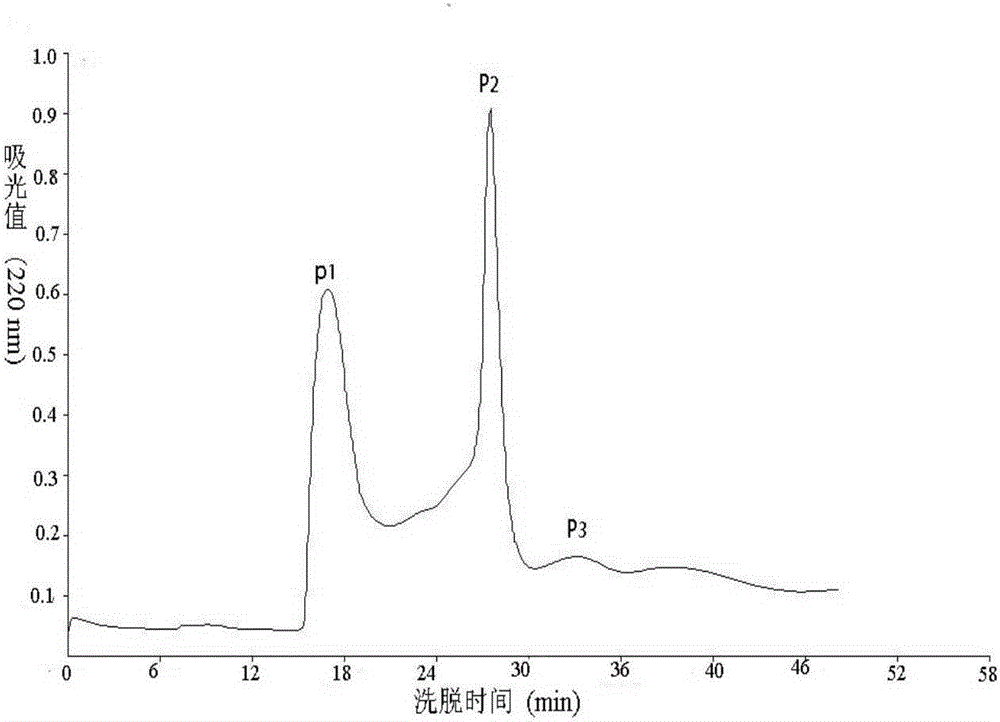An active polypeptide isolated from anchovy
An active polypeptide, anchovy technology, applied in the field of polypeptide separation, can solve problems such as underutilization of resources, and achieve the effects of increasing total antioxidant capacity, reducing nerve cell damage, and increasing SOD activity.
- Summary
- Abstract
- Description
- Claims
- Application Information
AI Technical Summary
Problems solved by technology
Method used
Image
Examples
Embodiment 1
[0034] Example 1 Preparation of Anchovy Yeast Liquid
[0035] The by-products of the anchovy were minced with a mincer, and then coarsely filtered to remove impurities, and then heated at 80°C for 2 hours to a viscous semi-solid state to obtain an anchovy concentrate; the anchovy concentrate was subjected to (1:3, w / w) Add water in the proportion of ), mix well, add 3% flavor protease by weight of the anchovy concentrate, and hydrolyze at 60°C for 5 hours to obtain anchovy hydrolysate. The obtained anchovy enzymatic hydrolysate was added with 5% of the weight of the enzymatic hydrolysate of bran, sterilized at 121°C for 20 minutes, connected to Aspergillus oryzae, fermented at 30°C, and the fermentation period was 3 days. After the fermentation is finished, the obtained fermentation broth is filtered with gauze and sterilized at 100° C. for 20 min to obtain the finished product of anchovy yeast solution.
[0036] The physical and chemical indexes of the anchovy hair yeast liquid a...
Embodiment 2
[0041] Example 2 Active peptide G-15 gel chromatography
[0042] After the obtained anchovy yeast liquid is frozen into a dry powder with a freeze dryer, it is dissolved in ultrapure water to form a solution with a concentration of 0.1g / mL, passed through a 0.45μm inorganic water film, and applied to G-15 gel chromatography The column was separated, the loading volume was 1 mL, distilled water was used as the eluent, the flow rate was 1 mL / min, the detection wavelength was 220 nm, and the components with the highest anti-nerve cell damage activity were collected.
[0043] Such as figure 1 As shown, the sample is divided into three elution peaks after passing through the G-15 gel chromatography column, and the elution time is 16.5~18.5min (P 1 Peak), 27~30min(P 2 Peak), 30~36min(P 3 Peak), the anti-neuronal damage activity of the three peaks was measured, and it was found that P 2 Peak has the highest activity against neuronal damage, collect P 2 Peaks, ready to be separated and puri...
Embodiment 3
[0044] Example 3 DEAE-SepharoseFF ion exchange column chromatography of active polypeptide
[0045] The P with the highest anti-nerve cell damage activity obtained in the previous step 2 The peak is further separated and purified by DEAE-SepharoseFF ion exchange column chromatography, and the concentrated sample is placed on a DEAE-SepharoseFF ion exchange column (18×80mm) equilibrated with 5mM Tris-HCl (pH8.5) buffer, with a concentration of 0~2mol / LNaCl gradient elution, the flow rate is 1mL / min, the detection wavelength is 220nm, the components with the highest anti-neuronal damage activity are collected, dialyzed with Tris-HCl solution, and freeze-dried. See the results of DEAE-SepharoseFF ion exchange column chromatography for active peptide figure 2 .
[0046] Such as figure 2 , P 2 After passing DEAE-SepharoseFF, three elution peaks are formed. The elution time is 3~6min (peak A), 13~20min (peak B), 32~37min (peak C). The three peaks are anti-neuronal cell damage The act...
PUM
| Property | Measurement | Unit |
|---|---|---|
| molecular weight | aaaaa | aaaaa |
Abstract
Description
Claims
Application Information
 Login to View More
Login to View More - R&D
- Intellectual Property
- Life Sciences
- Materials
- Tech Scout
- Unparalleled Data Quality
- Higher Quality Content
- 60% Fewer Hallucinations
Browse by: Latest US Patents, China's latest patents, Technical Efficacy Thesaurus, Application Domain, Technology Topic, Popular Technical Reports.
© 2025 PatSnap. All rights reserved.Legal|Privacy policy|Modern Slavery Act Transparency Statement|Sitemap|About US| Contact US: help@patsnap.com



